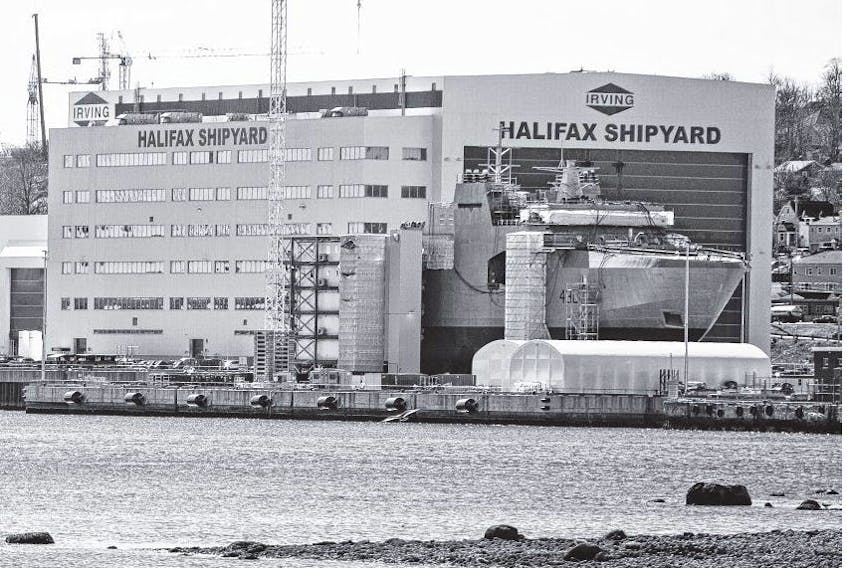The U.K. government says it hopes to have an “open book” style relationship with Canada when it comes to shipbuilding.
Speaking with media at the Canadian Association of Defence and Security Industries in Ottawa on Wednesday, Guto Bebb, the U.K.’s minister for defence procurement, said his country is happy to offer full discussion and disclosure to Canada as both countries work on rebuilding their shipbuilding industries and equipping their navies.
“We see the potential of having two powers who share Five Eyes (intelligence). We think that’s a really constructive way forward,” Bebb said.
“Our intention is not to say to Canada that we know how to do this, because I can assure you there have been challenges along the way. . . . I think we’re very confident that the lessons that we have learned going through process are of value.”
Canada is building a whole array of ships to outfit the Royal Canadian Navy and Canadian Coast Guard under the multibillion- dollar National Shipbuilding Strategy. The U.K. is doing much the same: In 2017 it commissioned the first of two Queen Elizabeth-class aircraft carriers, and is in the process of building the first three of eight BAE Systems- designed Type 26 global combat ships, which Bebb said are expected to be delivered by 2025. The Canadian government is hoping to build 15 warships at Irving Shipbuilding in Halifax at a cost of about $60 billion starting in the 2020s.
The Type 26 also happens to be one of three vessels in the running for the Canadian Surface Combatant — the largest and most expensive part of the National Shipbuilding Strategy. The U.K.’s BAE Systems is offering the
Type 26 design while Lockheed Martin Canada, the other half of the consortium, is providing the combat systems integrator. Lockheed Canada has a history with the Royal Canadian Navy and the system they are offering is an updated version of the technology that is being used in the Halifaxclass frigates.
The BAE-designed Type 26, arguably the most advanced warship in the world, has not comewithout controversy on both sides of the pond. In the U.K., planning for the Type 26 began in the late 1990s but the program was delayed significantly due to cost constraints and debates over capabilities. In Canada, the federal government was accused of bid-rigging when it broadened the request for proposal requirements to allow for designs that have not been used by any navies, like the Type 26, something Ottawa denies.
Experts and industry insiders have also suggested that the Type 26 is the Canadian navy’s preferred design, and that combined with BAE’s partnership with Lockheed’s Canadian arm positions the Type 26 well in the competition.
Despite concerns with delays and costs in the U.K., Bebb said his government is pleased with the procurement.
“We’re of the view that the whole situation in the U.K. is meeting with our expectations; initial steel has been cut, we are seeing the first blocks already being completed (at) the Clyde(shipyard),” he said, adding that lessons learned during the aircraft carrier procurement will ensure Type 26 is delivered on time.
Speaking with The Chronicle Herald, Giles Whitefield, BAE’s international businessdevelopment director for its naval division, said the ship they’re offering Canada is essentially
identical to the U.K. design when it comes to the hull, but tailored to Canada’s needs.
Whitefield said the cost of the vessels will be driven less by the ship design and more by the procurement process and the various systems.
“The cost of building ships isn’t necessarily the cost of the ship itself, it’s the length of the program — if you build 15 ships in 15 years, it’s significantly cheaper than building 15 ships in 25 years and that’s actually a bigger driver than whether you pick this ship or that ship,” he said.
David Perry, senior analyst with the Canadian Global Affairs Institute, said much of the cost of the ship that is chosen will have to do with how much of the submitted off-the-shelf design Canada decides to change. This won’t be known for some time as Canada is still evaluating the initial request for proposal submissions.
Perry also said Canadians ought to be careful in assuming delays in other countries — with the Type 26 or any other design — is reflective of the quality of the design itself.
“As an example, the glacial pace at which we’re buying fighter (jets) I don’t think really says anything really bad about potential fighter options,” he said.
The two other designs in the running are Alion Canada’s Dutch De Zeven Provinciën Class airdefence and command frigate, and Navantia/SAAB’s design based on the F-105 anti-submarine frigate design for the Spanish navy.









